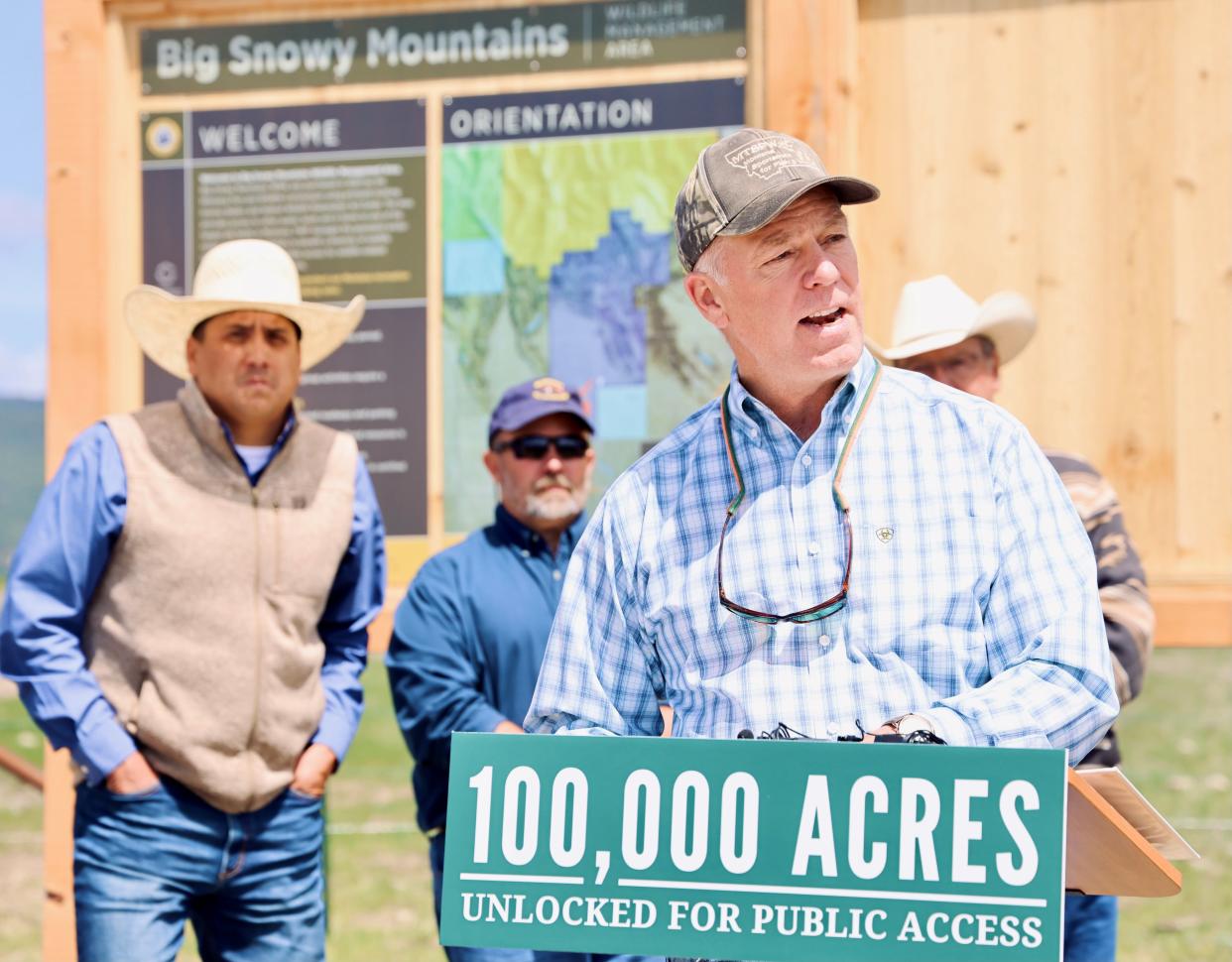New Wildlife Management Area opens 100,000 acres to public access

Central Montana’s newest wildlife management area opened to the public for the first time Monday, breaking the lock that once blocked access to tens of thousands of acres of mountain foothills and prairie grasslands that had been off limits to most Montanans for decades.
“It’s a great day in Montana as we celebrate unlocking over 100,000 acres of public land for folks to enjoy in the Big Snowy Mountains,” Montana Governor Greg Gianforte said during a ceremony at the entrance to the newly established Big Snowy Mountains Wildlife Management Area (WMA). “Not only are we opening access for hunters to pristine wildlife habitat, but also, we’re keeping the land available for cattle grazing to keep ranchers on the landscape. This is a win-win for Montana.”
The Big Snowy Mountains are an isolated “island range” of low-elevation mountains rising above the edge of eastern Montana’s high plains. Located roughly halfway between Lewistown to the north and Ryegate in the south, the new Wildlife Management Area contains a diverse landscape of grasslands and forested ridges, prime habitat for elk, black bear, mule deer and pronghorn.
“We have a vested interest in seeing land conserved for wildlife habitat while also keeping ranchers on the landscape,” Gianforte remarked during Monday’s opening ceremony. “This project accomplishes both, and it’s something to be proud of.”
The foundation story of the Big Snowy Mountains WMA begins with Forrest Allen, a Montana farmer/rancher who grew up working on his family’s sheep and cattle ranch along the edge of the Big Snowy Mountains 20 miles north of Rygate. Born in Big Timber in 1921, Allen was a World War II veteran who relocated to a homestead near Cody, Wyoming in the 1950s. But Allen never forgot his ties to central Montana. Upon his death in 2019, Allen bequeathed 5,677-acres of his family’s ranch in Golden Valley County to Shodair Children’s Hospital.
Shodair Children’s Hospital was founded as result of a similar donation 127 years ago. In 1896 pioneer grocer Louis W. Shodair gifted a home in Helena for the establishment of an orphanage. A later contribution of $200,000 from Shodair in the 1930s enable the completion of Montana’s first children’s orthopedic hospital. Today, Shodair Children’s Hospital is a leading source of psychiatric care and medical genetics services for children and adolescents.
Allen’s gift was a great windfall for Shodair, but also presented something of a dilemma. The hospital was not equipped to manage a large farming/ranching operation and was simultaneously wading into a $66 million expansion of its hospital and medical genetics program in Helena. The obviously solution was to find a willing buyer for the Allen property.
“We knew form the very beginning this was not going to be land we were going to take and hold onto,” said Shodair Chief Executive Officer Craig Aasved.
The hospital fielded several inquiries from potential out-of-state buyers but held back hoping to find a buyer who would guarantee public access to the property.
“We’re a Montana company, we wanted it to stay in Montana, and we wanted access for the citizens of Montana,” Aasved said.
In 2020 Shodair contacted the Rocky Mountain Elk Foundation to see if some kind of conservation outcome for the property could be arranged.
The Allen ranch sat at a key chokepoint to a much larger complex of “landlocked” public lands, largely blocked to public entry by private land holdings with no public road or trail access. Directly north lay the 7,000-acre Twin Coulee Wildlife Management Area administrated by the Bureau of Land Management, and adjacent to that was more than 90,000-acres managed by the U.S. Forest Service as the Big Snowy Mountain Wilderness Study Area.
Officials at Montana Fish, Wildlife and Parks (FWP) were intrigued by the possibilities, due in some degree to the department’s longstanding difficulty in managing elk populations in the Big Snowy Mountains.
“Elk herd management in the Big Snowies is a major concern, said FWP Wildlife Biologist Ashely Taylor,” one that’s continually exacerbated by the reluctance of a few large landowners to permit public access.”
Montana’s current Elk Management Plan calls for a target population of 800 elk in the Snowies. Current estimates are that more than 8,000 Roosevelt elk inhabit the area; a herd that is now 20-times larger than the one recorded 30 years ago when fewer than 400 elk wandered the area.
“Public access is a big portion of that,” Taylor said of the elk herd management challenges in the Big Snowies. “We manage a lot of our elk number with public hunting. Getting those public hunters on to where the elk are located has been a challenge.”
In 2020 the Fish Wildlife and Parks Commission gave its initial endorsement to the state of Montana purchasing the land, an endorsement that was later approved by the Montana State Land Board.
The $8.22 million purchase price was funded in large part by Pittman Roberson funds, which are derived through an 11% federal excise tax on sporting arms, ammunition, and archery equipment, and a 10% tax on handguns.
As part of the purchase agreement, Gianforte proposed a covenant requiring the state keep the land available for cattle grazing. Closure on the deal was announced last fall.
“I can’t say thank you enough to all the partners involved in this project,” said Aasved at the grand opening. “I grew up in the Snowy Mountains on the other side, so to be a part of this is a legacy I’ll cherish forever.”
This article originally appeared on Great Falls Tribune: New wildlife management area opens up Montana's Big Snowy Mountains

